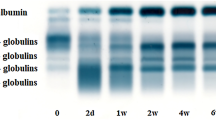Abstract
DURING a survey of fœtal types of hæmoglobin, the cord blood samples of 368 White and 1,192 Negro infants were examined, and a possibly new fœtal variant was found in one White and three Negro infants. All four babies were born at term, and all appeared healthy. In their hæmolysates, the F hæmoglobin values, by the method of alkali denaturation1, ranged between 68 and 82 per cent, and in zone electrophoresis there was about 15 per cent or less, each, of hæmoglobin A and the variant. Two of the Negro babies were siblings, and the samples from the younger of these (L. C. W.) and from the unrelated Negro infant (W. T.) were examined in detail. In paper electrophoresis, barbital buffer, pH 8.6 (Fig. 1) the variant, tentatively called ‘Texas’, forms a broad band with a suggestion of two components, moving slightly more cathodally than hæmoglobin C, and in agar electrophoresis, citrate buffer, pH 6.2, it moves between hæmoglobins F and A (Fig. 2). In starch gel electrophoresis in tris borate buffer, pH 8.6, the mobility is similar to that of hæmoglobin C, as is also the case in starch block electrophoresis, barbital buffer pH 8.6. In these latter two methods a small amount of a hæmoglobin fraction of the mobility of Bart's was detectable in each hæmolysate. The Texas variant, eluted from the starch block, was examined with respect to its rate of alkali denaturation, by the method of Jonxis and Visser2, and the values obtained were similar to those of a mixture of about 0.75 A and 0.25 F. In its ultra-violet absorption spectrum, as determined in the Beckman DU spectrophotometer, there were 2 tryptophan fine-structure bands, one at a wave-length of 288–289 mµ and the other at 290–291 mµ.
This is a preview of subscription content, access via your institution
Access options
Subscribe to this journal
Receive 51 print issues and online access
$199.00 per year
only $3.90 per issue
Buy this article
- Purchase on Springer Link
- Instant access to full article PDF
Prices may be subject to local taxes which are calculated during checkout
Similar content being viewed by others
References
Singer, K., Chernoff, A. I., and Singer, L., Blood, 6, 413 (1951).
Jonxis, J. H. P., and Visser, H. K. A., Amer. J. Dis. Child., 92, 588 (1956).
Muller, C. J., Molecular Evolution (Van Gorcum and Co., Assen, Holland, 1961).
Huehns, E. R., Flynn, F. V., Butler, E. A., and Beaven, G. H., Nature, 189, 496 (1961).
Horton, B. R., Thompson, R. B., Dozy, A. M., Nechtman, C. M., Nichols, E., and Huisman, T. H. J., Blood, 20, 302 (1962).
Author information
Authors and Affiliations
Rights and permissions
About this article
Cite this article
SCHNEIDER, R., ARAT, F. & HAGGARD, M. An Inhomogeneous Fœtal Hæmoglobin Variant (the Texas Type). Nature 202, 1346–1347 (1964). https://doi.org/10.1038/2021346b0
Issue Date:
DOI: https://doi.org/10.1038/2021346b0
Comments
By submitting a comment you agree to abide by our Terms and Community Guidelines. If you find something abusive or that does not comply with our terms or guidelines please flag it as inappropriate.



